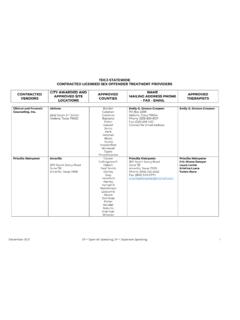Transcription of The Effectiveness of Treatment for Adult Sexual Offenders
1 Department of Justice Office of Justice Programs Office of Sex offender Sentencing, Monitoring, Apprehending, Registering, and Tracking SOMAPIRESEARCH BRIEF SEX offender MANAGEMENT ASSESSMENT AND PLANNING INITIATIVE Luis , Director July 2015 The Effectiveness of Treatment for Adult Sexual About SOMAPI Offenders In 2011, the SMART Office began work on the Sex offender Management Assessment and Planning Initiative (SOMAPI), a project designed to assess the by Roger Przybylski state of research and practice in sex offender management.
2 As part of the effort, the SMART Office contracted with the National Criminal Justice Association (NCJA) Introduction and a team of subject-matter experts to review the literature on Tsexual offending and sex offender herapeutic interventions aimed at reducing the likelihood of reoffending management and develop summaries of the research for are a staple of contemporary sex offender management practice. Although dissemination to the field. These summaries are available online at criminal Offenders overall, the Effectiveness of Treatment for sex Offenders has html.
3 Been subject to debate. A national inventory of This brief addresses the Effectiveness of Treatment for Adult Sexual Offenders . sex offender management professionals also was conducted in 2011 to gain insight about promising practices and pressing needs in the field. Finally, a that have emerged from the extant research. Discussion Forum involving national experts was held in 2012 for the purpose of reviewing Summary of Research Findings the research summaries and inventory results and refining what is currently known about sex The Effectiveness of Treatment for sex Offenders has been assessed in both offender management.
4 Individual studies and synthesis research. There is general agreement in Based on the work carried out the research community that, among individual studies, well-designed under SOMAPI, the SMART Office has published a series of Research and executed randomized controlled trials (RCTs) provide the most Briefs, each focusing on a topic trustworthy evidence about an intervention s Findings from covered in the Sexual offending and sex offender management literature review. Each brief is about the Effectiveness of an intervention can be Synthesis studies, designed to get key findings such as a systematic review3 or meta-analysis,4 from the literature review into the hands of policymakers and many individual studies and are undertaken to reach conclusions about an practitioners.
5 Overall, the briefs are intervention s Effectiveness based on an entire body of relevant research. When intended to advance the ongoing dialogue related to effective systematic reviews and meta-analyses are done well, they arguably provide interventions for Sexual Offenders and provide policymakers and practitioners with trustworthy, up to-date information they can use to identify what works to combat Sexual offending and prevent Sexual victimization. 2 the most trustworthy evidence about an intervention s Effectiveness . Findings From Individual Studies One of the few studies to use an RCT design to evaluate the Effectiveness of Treatment for Adult sex Offenders was conducted by Marques and colleagues (2005).
6 Widely known as the California Sex offender Treatment and Evaluation Project (SOTEP), the study examined the effects of a cognitive-behavioral/relapse prevention program on the recidivism of sex Offenders who were serving prison sentences for child molestation or rape. Based on a mean follow-up period of approximately 8 years, the study found no significant differences in Sexual or violent recidivism between treated sex Offenders and two untreated control groups. Due to its use of random assignment, the SOTEP study is frequently cited as evidence that Treatment for sex Offenders is ineffective.
7 However, Marques and her colleagues (2005) have pointed out that the study s Treatment and control groups likely differed in important ways, and the Treatment program itself did not fully adhere to the risk-need-responsivity (RNR) principles of effective intervention. Moreover, some of the Treatment subgroups such as high-risk Offenders who got it, meaning that they derived benefit from the program or basically met specified Treatment goals recidivated at a significantly lower rate than Offenders who did not get it. Given the findings from the SOTEP study, it is important to recognize that Treatment Effectiveness can be dependent on a variety of factors, including the Treatment climate, program delivery, and how the participant responds to Treatment (Friendship, Mann, and Beech, 2003, p.)
8 4). In their study of community-based Treatment , for example, Beech and colleagues (2001) found that Offenders who were responsive to Treatment (based on change in pro-offending attitudes) were less likely to sexually recidivate than Offenders who were not. Several recent studies conducted in prison-based settings also suggest that Treatment For example A study of a program in a Canadian prison that employed a cognitive-behavioral approach and subscribed to the RNR principles of effective intervention found that Treatment produced significant reductions in Sexual recidivism (Oliver, Wong, and Nicholaichuk, 2008).
9 Treated sex Offenders in the study had Sexual reconviction rates of percent after 5 years and percent after 10 years, compared to Sexual reconviction rates for the untreated sex Offenders of percent after 5 years and percent after 10 years of followup. A study of a prison-based therapeutic community Treatment program in Colorado found that participation in Treatment was significantly related to success on parole (Lowden et al., 2003). Sex Offenders who completed Treatment and participated in aftercare had revocation rates three times lower than untreated sex Offenders .
10 Each additional month spent in Treatment increased the likelihood of success upon release by 1 percent (12 percent per year). In Minnesota, Duwe & Goldman (2009) found that participating in Treatment significantly reduced the likelihood and pace of recidivism. For Offenders who completed Treatment , the observed Sexual , violent, and general rearrest recidivism rates were percent, 29 percent, and percent, respectively. By comparison, the observed Sexual , violent, and general rearrest rates for sex Offenders who did not participate in Treatment were percent, percent, and percent.









